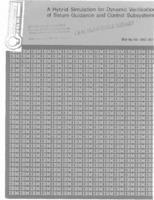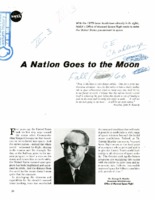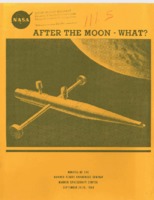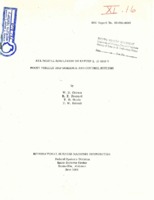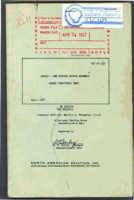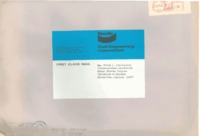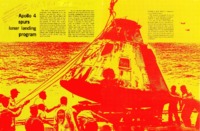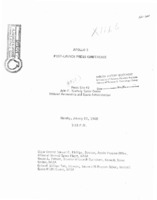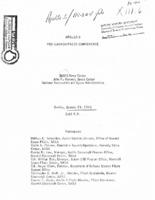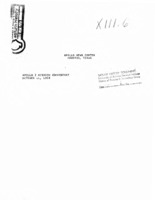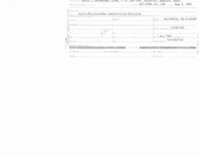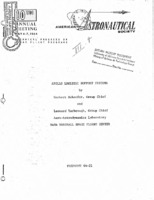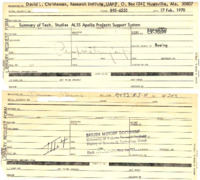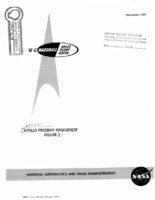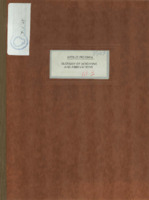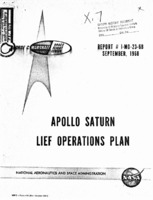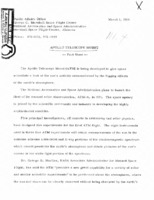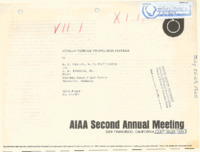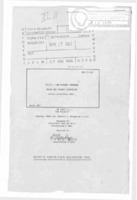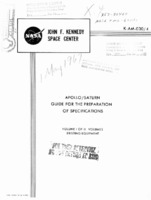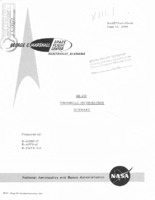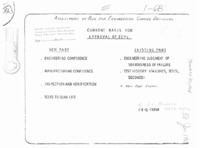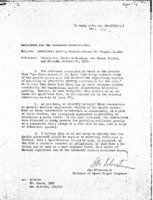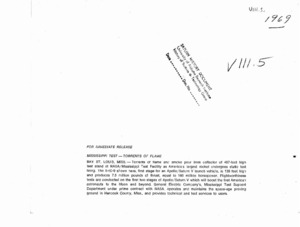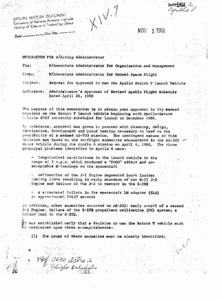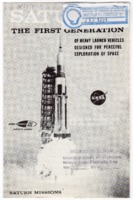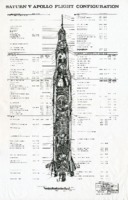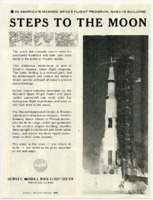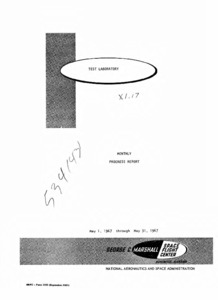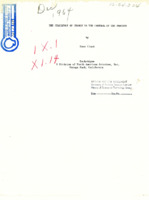
Browse Items (204 total)
Sort by:
-
"4-23-72, Apollo 16 Launch."
The first half of the film shows Konrad Dannenberg surveying the stands for spectators of Apollo 16 at the launch complex in Cape Canaveral, Florida. The second half of the film follows the rocket as it lifts off from the launch pad and ascends out of view. Spring 1972. -
"A Hybrid Simulation for Dynamic Verification of Saturn Guidance and Control Subsystems."
This paper presents a discussion of a hybrid simulation used to dynamically verify the Saturn Guidance and Control subsystems. First, the Saturn vehicle is briefly described to provide background information. The Instrument Unit (IU) is considered in more detail to give a proper setting for the Guidance and Flight Control (G and FC) discussion that follows. After a brief description of the actual G and FC System operation, simulation models of the G and FC components are considered in detail. This is followed by a discussion of the model assignment to a particular computer (digital or analog) and justification for making that assignment. Finally, results of the AS-204/LM1 hybrid simulation studies are briefly considered with mention of the actual flight data. -
"A Nation Goes to the Moon."
Written by NASA Office of Manned Space Flight Associate Administrator George E. Mueller, this is an article from G. E. Challenge, Fall 1966, page 26 to 32. -
"After the Moon - What? Minutes of the Manned Flight Awareness Seminar."
The seminar was held at the Manned Spacecraft Center, September 25-26, 1969. -
"All Digital Simulation of Saturn I, IB, and V: Boost Vehicle and Guidance Control Systems."
The introduction notes, "The Saturn V launch vehicle is being developed by the National Aeronautics and Space Administration's George C. Marshall Space Flight Center for Project Apollo; Saturn I and Saturn IB vehicles are providing the early testing and support for Project Apollo. The nerve center of the Saturn is its guidance and control system. An airborne digital computer provides the link which closes both the guidance and control loops,making verification of the flight computer program of vital importance. During a powered flight this onboard digital computer program can be divided into four major parts:a) guidance, including navigation, b) control, c) vehicle sequencing, and d) computer telemetry." -
"Apollo - LEM Docking Drogue Assembly Static Structural Test."
This document contains the tests and test results from structural tests performed on the Apollo LEM docking drogue assembly between January 11, 1967 and February 15, 1967. The document contains various graphs, diagrams, and images pertaining to the tests. -
"Apollo 15 (Apollo 11 or 12?)."
Konrad Dannenberg goes to see one of the later Apollo flights liftoff from Cape Canaveral, Florida. This film contains a lot of shots of the spectator gallery as well as the lauch and disappearance of the Saturn V launching vehicle. 1969. -
"Apollo 15 Launch - Satellite model."
Konrad Dannenberg tours the visitor stand for the launch of Apollo 15. Of paticular note is a scale model the is on display showing a cross-section of the Skylab space station, as well as brief shots of the Saturn V launcher and the Vehicle Assembly Building. 1971. -
"Apollo 16 Pre-launch, 4-23-72."
Ingeborg and Konrad get ready for the launch of Apollo 16. They are shown boarding a bus from their hotel in Cape Canaveral, Florida which conveys them to the visitor stands to watch the launch. While on the road to the stands, Konrad captures pictures of the vehicle assembly building and the rocket on the launchpad. Spring 1972. -
"Apollo 5 Post-Launch Press Conference."
This document contains the transcription from the Apollo 5 post-launch press conference, including all the questions asked and answers given by participants Major General Samuel C. Phillips, Rocco A. Petrone, and Colonel William Teir. -
"Apollo 5 Pre-Launch Press Conference."
This document contains a transcript of the pre-launch conference, including the questions asked and the answers given by participants William C. Schneider, Rocco A. Petrone, George M. Low, Col. William Teir, Col. Royce Olson, Christopher C. Kraft, Jr., and Eugene F. Kranz. -
"Apollo 6 Pre-Launch Press Conference."
The press conference was given at Cape Royal News Center in Cocoa Beach, Florida, on Wednesday, April 3, 1968, at 3:30 PM. Participants: William C. Schneider, Apollo Mission Director, NASA; George M. Low, Apollo Spacecraft Manager, NASA; Clifford Charlesworth, Apollo 6 Flight Director, Manned Spacecraft Center, NASA; Dr. Arthur Rudolph, Saturn V Program Office, Marshall Space Flight Center, NASA; Rocco A. Petrone, Apollo 6 Launch Director, Kennedy Space Center, NASA; Col. Royce Olson, USAF, Director DOD Manned Spaceflight Support Office, Patrick AFB; Chris Kraft, Director of Flight Operations, Manned Spacecraft Center. -
"Apollo 7 Liftoff, Oct '68."
View from the spectator's gallery at Cape Canaveral as Apollo 7 launches. The film tracks the rocket from when the engines are ignited to when it disappears from view. Fall 1968. -
"Apollo 7 Mission Commentary."
This document contains the transcript from the Apollo 7 mission. This transcript contains the communication from the first seven days of the ten day mission. -
"Apollo Documentation Administration Instruction."
According to the foreword found on page i, this document includes instructions on "procedures, methods and practices...necessary for the effective management of a program documentation system." -
"Apollo Logistic Support Systems."
According to an abstract found on the page following the title page, this paper includes "one possible conceptual definition of an early Apollo Logistics Support Systems (ALSS) is presented and various payloads for the system are briefly discussed. " It also discusses the Lunar Mobile Laboratory (MOLAB) and other considerations for a lunar scientific mission. -
"Apollo Logistics Support System (ALSS) Payloads Summary Report."
This report includes a summary of the major tasks performed by the Apollo Logistics Support System Payloads with an emphasis on the Lunar Mobile Laboratory (MOLAB). -
"Apollo Program Management Volume 3."
According to the introduction found on page ii, this document was created to detail the "MSFC segment of the total Apollo Management process and to describe the methodologies and techniques currently being implemented." -
"Apollo Program: Glossary of Acronyms and Abbreviations."
This glossary contains acronyms and abbreviations commonly found in documentation from the Apollo Program. This glossary is meant to be a tool for historians and other researchers. -
"Apollo Saturn LIEF Operations Plan."
This paper identifies the support functions performed by MSFC through the Launch Information Exchange Facility (LIEF) during the Apollo Saturn Mission Operations and other facilities required to carry out these functions. It also identifies mission specific documents required for operation. Note that page 20 is missing. -
"Apollo Telescope Mount Fact Sheet."
This fact sheet contains information related to the Apollo Telescope Mount, or ATM, which allows scientists to look at the activity of the sun through the fogging effects of the earth's atmosphere. -
"Apollo Vehicle Propulsion Systems."
This paper discusses the propulsion requirements for various stages of the Apollo vehicles and the development of these engines. -
"Apollo-LEM Docking Combined Probe and Drogue Assemblies Static Structural Test."
This document contains the test technical report and results for the LEM docking probe and drogue assemblies to demonstrate that the assemblies would sustain enough load to capture latch. The document contains various graphs, diagrams, and images from testing. The final page contains a note that page no. A-139 is missing from the report. -
"Apollo/Saturn Guide for the Preparation of Specifications: Volume I of II Volumes."
According to the purpose found in section 1.1, "Volume I provides a guide for the preparation of specifications for existing equipment in the Apollo/Saturn Program." -
"Approach in Achieving High Reliability for Saturn Class Vehicles."
This paper focuses on an approach for achieving high reliability within the Navigation, Guidance, and Control systems of the Saturn class launch vehicles. -
"AS-203 Technical Information Summary."
"This report outlines, through a series of sketches with accompanying text, the general features of the SA-203 Launch Vehicle and information on launch preparation, the launch facility and mission peculiar experiments." -
"Assessment of Risk for Engineering Change Decisions."
This document includes the current basis for approval of ECPs, fatigue life after stress reduction, and other probability and comparative risk assessments. On the first page there is an inscription, "By E.L. Bombara NASA-MSFC." -
"Daytona Beach - Apollo 15 - Traffic Jam."
The Dannenbergs travel down to Daytona Beach, Florida, to see the launch of Apollo 15. The first half shows the resort and Ingeborg sitting by the beach. The second half shows the drive to the launch facility in Cape Canaveral, Florida and the traffic they find upon arrival. 1971. -
"Educational Lift-Off: Dedication 1969."
The program dedicates three new Huntsville schools, each named for a member of the Apollo crew that died in the pad fire of February 21, 1967. This program was included in one of two scrapbooks that Christel and George McCanless made for UAH history professor Frances Roberts in 1969. -
"Film of Apollo 11 launch. LBJ, Spiro Agnew, Johnny Carson, Hugh O'Brian, Barry Goldwater, Lady Bird Johnson, Hermann Oberth..."
This film shows the "VIP" section of seating for the Apollo 11 launch. The film shows them going to the stands and then watching the rocket as it takes off. Included are many contemporary celebrties, such as Lyndon B. Johnson, Spiro Agnew, Johnny Carson, Hugh O'Brian, Barry Goldwater, Larry Bird Johnson, and Hermann Oberth. -
"Memorandum for the Associate Administrator: Artificial Gravity Considerations for Project Apollo."
This memorandum contains artificial gravity considerations for Project Apollo and was directed to Seamans, Wernher von Braun, Donlon, and Gilruth. Silverstein writes that he believes it is too early to tell if the Apollo spacecraft is capable of providing artificial gravity. -
"Mississippi test - torrents of flame."
Description of a photograph of a rocket static test firing. -
"Request for approval to man the Apollo Saturn V Vehicle."
The purpose of this memorandum is to obtaln your approval to fly manned missions on the Saturn V launch vehicle beginning with Apollo-Saturn vehicle #503 currently scheduled for launch in December 1968. -
"Saturn I: The First Generation of Heavy Launch Vehicles Designed for Peaceful Exploration of Space."
The leaflet outlines the history of Saturn launches and gives a physical description of the rocket. The description includes a diagram of each stage; specifications of each stage's thrust, propellants, liftoff weight, and burning time; and engine specifications. -
"Saturn V Apollo Flight Configuration."
Drawn by Don Sprague at the Huntsville Engineering section of Boeing. -
"Steps to the Moon."
This flier highlights Marshall Space Flight Center's role in the lunar landing and illustrates each step of a successful mission, from liftoff at Kennedy Space Center to splashdown in the Pacific Ocean. -
"Test Laboratory monthly progress report : May, 1967."
Progress report for May, 1967. -
"The Challenge of Change vs the Control of the Process."
The introduction states, "This paper is designed to present the Rocketdyne engine program as it applies to the Saturn launch vehicles and will apply to the Apollo program of manned flight to the moon (Fig. 1). The vehicle that will launch this flight is the Saturn V, the largest and most powerful of the Saturn family. This vehicle, 362 feet tall and 33 feet in diameter, will be capable of sending a 45-ton payload to the moon or placing a 120-ton payload in earth orbit. Five F-1 engines power the first stage of the Saturn V; five J-2 engines, the second stage; and one J-2 engine, the third stage. The thrust of the first-stage engines alone will be equivalent to 160 million horsepower. Both of these engines, the F-1 and the J-2, were designed at, and are currently being produced by Rocketdyne."

